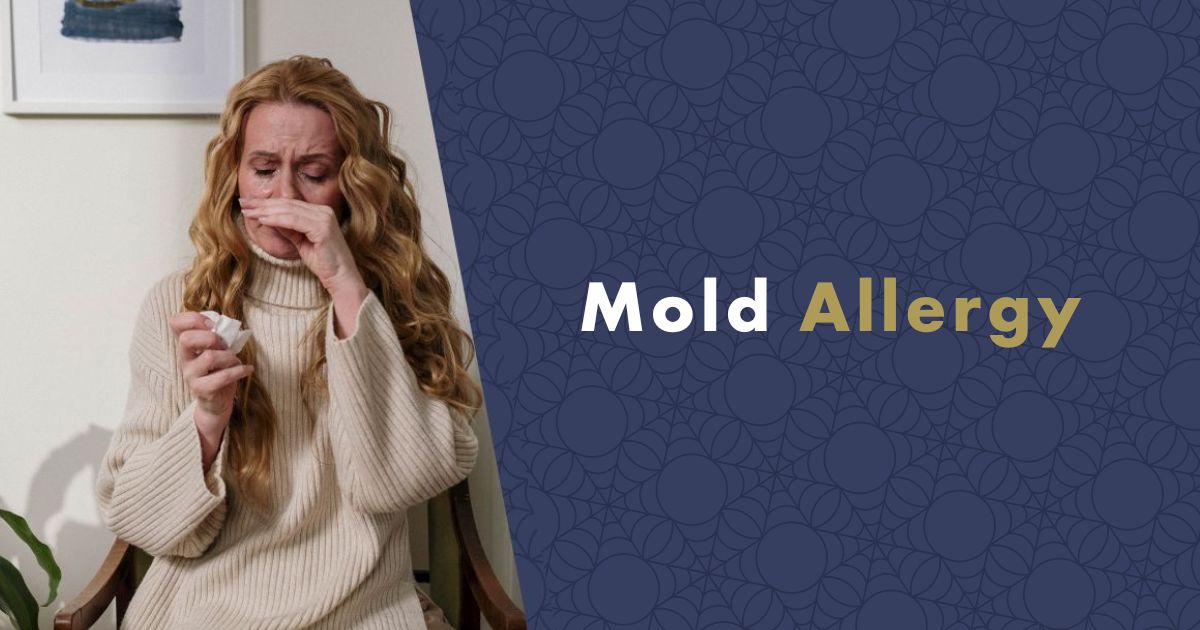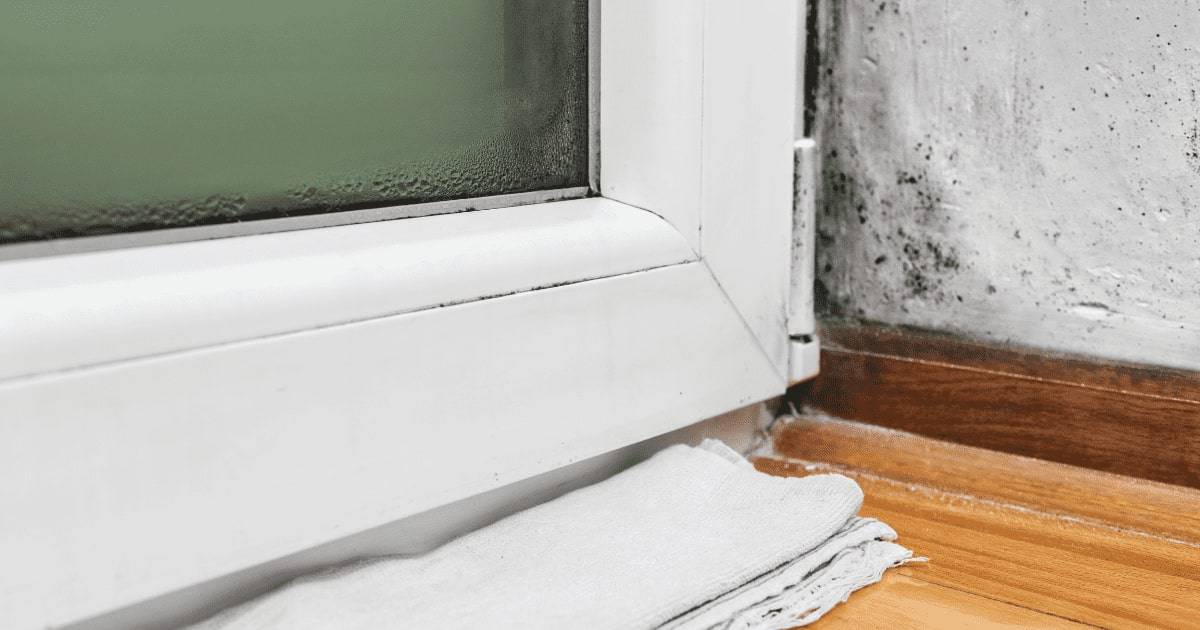Mold allergy is a growing problem in society. Every year, the number of people suffering from this allergy increases, primarily due to the poor condition of the domestic environment and the lack of public awareness. It usually involves respiratory problems accompanied by unpleasant symptoms such as itching, difficulty breathing, coughing, skin rashes, and more. In this article, we will look at the causes of mold allergy, its symptoms, and possible prevention methods to keep your home mold-free and reduce the risk of allergic reactions.

What Is Mold and Where is it Found?
Molds are microscopic fungi that can reproduce in almost any environment. For their optimal growth and spore formation, they require a temperature between 25 and 30 °C, darkness, and sufficient moisture. However, they can also grow at minimal temperatures and low oxygen levels. They reproduce through small particles called spores, which can survive even under extreme conditions.
How Is Mold Spread and Where?
Mold spores are spread through the air, so allergic symptoms usually affect the respiratory system. Molds prefer moist and dark environments. Moisture and poor ventilation create ideal conditions for their growth. They can occur in various places, both outdoors and indoors. Bathrooms, kitchens, basements, and areas with leaky ceilings or walls are common places where molds are found.
What Are the Symptoms of Mold Allergy?
Allergic reactions to mold can have various physical manifestations. The most common symptoms include:
- Respiratory problems such as coughing and wheezing
- Nasal congestion, itching, sneezing, increased watery nasal discharge, and swollen nasal mucosa
- Itching, redness, and tearing of the eyes
- Skin rashes and itching
- Fatigue and irritability
If a person is allergic to mold, these symptoms may occur upon exposure to molds and persist until the allergen is removed. Long-term exposure to molds can have a negative impact on health, especially in individuals with asthma or weakened immune systems.
TIP: You can read more about allergic rashes and their treatment HERE.
How Is Mold Allergy Diagnosed?
The diagnosis of mold allergy involves a medical history, physical examination, and allergological tests. How does it typically proceed?
- Medical History: The doctor gathers information about your allergic symptoms and family history through questions. The questions relate to allergic symptoms, their timing, past allergic treatments, your lifestyle and environment. Based on this information, the doctor establishes a medical history.
- Respiratory Tests: Using various devices, the function of your lungs and possible symptoms of allergic inflammation are determined.
- Skin Tests: Drops of individual potential allergens are applied to the skin to measure the level of specific antibodies.
TIP: You can read about how to recognize an allergy HERE.
Treatment of Mold Allergy
Prevention and minimizing exposure to molds are key to reducing allergic reactions. It is important to maintain a dry home environment and ensure proper ventilation.
Pharmacological treatment of mold allergy involves using anti-inflammatory drugs such as antihistamines that help reduce allergic reactions. Alternatively, immunotherapy may be prescribed, which is a long-term treatment that increases the body's tolerance to allergens.
Removal of Allergens
After establishing the diagnosis and identifying the harmful allergen, it is important to eliminate or minimize contact with this allergenic substance. This requires adjusting your lifestyle and following recommended measures.
Anti-allergy Medications
Commonly used medications for alleviating allergic symptoms include:
- Antihistamines, which block the effects of histamine (substances released from cells during allergic reactions) and thus suppress the allergic response.
- Bronchodilators, which dilate the airways that constrict during asthma attacks.
Anti-inflammatory drugs are also used, which act preventively and treat allergic inflammation. These medications include:
- Corticosteroids, which, when inhaled, have minimal side effects. These substances act locally in the lungs and are safe even with long-term use. They are primarily used for the treatment of allergic inflammation.
- Antileukotrienes, which block the effects of leukotrienes (substances produced by inflammatory cells during allergic reactions).
Immunotherapy with Allergen Vaccines
Immunotherapy is a method based on gradually increasing the body's tolerance to allergens. During this method, doses of allergens are progressively increased, allowing the immune system to adapt and respond less intensely to allergens. This can reduce or completely eliminate allergic symptoms and prevent severe reactions.
The goal of this therapy is to induce a state of tolerance to the allergen in the patient's body. Immunotherapy takes place for 2 to 5 years and involves administering allergen vaccines.
How to Keep Your Home Mold-Free
If you suffer from mold allergies, the first step is to eliminate the allergen as much as possible from your environment. Just like pollen, mold spores can easily enter your home through open windows. Here are a few tips on how to keep your home mold-free:
#produkty#https://www.nanospace.store/search/?string=functional+painting
- Keep the humidity in your home under control. Use air dehumidifiers and make sure there are no damp spots on walls or ceilings.
- Regularly ventilate the rooms
- Follow proper cleaning procedures. Clean mold from surfaces using specialized cleaning products and cloths that prevent the spread of spores.
- Limit sources of moisture, such as dripping faucets or leaky pipes.
TIP: If you already have visible mold at home (check walls on the northern side of the house, the back of furniture, and room corners), it's necessary to get rid of it as soon as possible. You can learn how to eliminate household mold in our article.

How to Remove Moisture in the House
The humidity in the air at home should not exceed 60%, especially in rooms prone to excessive moisture, such as the bathroom, kitchen, pantry, laundry room, or basement.
If regular ventilation and heating do not yield the desired results, it is advisable to use a dehumidifier. This device removes water vapor from the space and ensures air circulation with the help of a fan in the room it dehumidifies. This way, you can easily prevent the spread of mold in areas with increased humidity.
Using an Air Purifier to Combat Mold
Even if there is not high humidity at home, mold spores are commonly present in nature and constantly find their way into our homes through ventilation. The situation worsens particularly during the humid summer months.
Fortunately, there are air purifiers, which are one of the few options to eliminate mold spores in indoor environments. These spores are small and lightweight, but with a powerful fan and an efficient filter, air purifiers can easily and quickly handle them.
When choosing an air purifier, it is important to select one that corresponds to the size of the room in which it will be used.
#produkty#https://www.nanospace.store/ozone-generators/
Tips for Mold Allergy Sufferers
Allergy to mold is a common health issue that can have a negative impact on an individual's quality of life. It is important to be aware of the risks associated with molds and take preventive measures. In addition to maintaining a clean home environment with low humidity, you should also pay attention to these few other things:
- During periods when mold spores are most prevalent, it is not suitable to dry laundry outside. Spores can cling to clothing, and you will have an allergen with you at all times.
- Instead of carpets, which retain moisture, it is better to have washable flooring.
- Preventive measures can be taken against damp walls, such as insulation or special mold-resistant paint.
- After using sponges, cloths, rags, and mops, it is important to thoroughly wash them and let them dry properly.
- Regularly check stored food items to discard old or moldy food as soon as possible.
- It is also advisable to limit the cultivation of indoor plants because molds and their spores are often present in their soil.
- If you have air conditioning, it needs to be cleaned regularly as molds tend to thrive in such environments.
- If you suffer from mold allergies, it is best to avoid unnecessary visits to old and neglected houses, cabins, antique shops, libraries, and archives.
Mold Allergies in Children
Allergies to mold can have a particularly negative impact on children. Their immune system is not yet fully developed and is more sensitive to allergens. To protect children from mold allergies, it is important to maintain a clean home environment and minimize humidity. Regular ventilation, cleaning toys, and frequent changing of bedding are preventive measures. It is ideal to have an air purifier in the children's room to remove mold spores and other allergens like pollen from the air.
TIP: If you suffer from pollen allergies, read our article on how to cope with pollen allergy.
Learn More About Allergies:
FAQ
How long does it take to treat mold allergies?
The duration of mold allergy treatment varies for each individual. Some people may experience symptom improvement within a few weeks or months of treatment, while others may take longer.
Can molds cause serious health problems?
For sensitive individuals, molds can cause serious health problems, especially when exposed to high concentrations of molds over a prolonged period. This can worsen respiratory conditions such as asthma and have a negative impact on the immune system.
Is it possible to avoid mold allergy?
It is difficult to completely avoid mold allergy since molds are commonly present in the environment. However, by taking preventive measures such as maintaining a dry and clean home environment, exposure to molds can be minimized, reducing the risk of allergic reactions.
Can mold allergies trigger asthma?
Yes, mold allergies can be a trigger for asthma in sensitive individuals. Exposure to molds can worsen asthma symptoms such as shortness of breath and coughing.
What are the most common sources of mold in households?
The most common sources of mold in households are damp areas such as bathrooms, kitchens, basements, and places with leaky ceilings or walls. Molds can occur on moist surfaces such as showers, bathtubs, stoves, or behind cabinets and furniture where there is poor airflow.
What are the most common allergens in public buildings?
The most common allergens in public buildings are molds, dust mites, dust, and plant pollen. These allergens can be present in the air, on surfaces, or in air conditioning systems, increasing the risk of allergic reactions.
Is mold allergy curable?
Mold allergies cannot be completely cured, but their symptoms can be controlled through pharmacological treatment and prevention.
Sources:
Twaroch, T.E., Curin, M., Valenta, R. and Swoboda, I., 2015. Mold allergens in respiratory allergy: from structure to therapy. Allergy, asthma & immunology research, 7(3), pp.205-220.
Bozek, A. and Pyrkosz, K., 2017. Immunotherapy of mold allergy: A review. Human vaccines & immunotherapeutics, 13(10), pp.2397-2401.
Portnoy, J.M. and Jara, D., 2015. Mold allergy revisited. Annals of Allergy, Asthma & Immunology, 114(2), pp.83-89.
Rudert, A. and Portnoy, J., 2017. Mold allergy: is it real and what do we do about it?. Expert Review of Clinical Immunology, 13(8), pp.823-835.

